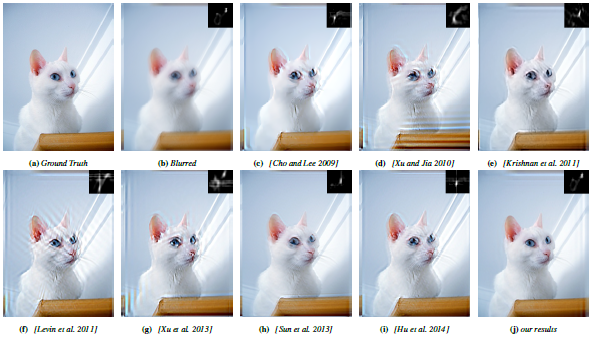Image Enhancement
The aim of this project is to recover an unblurred image and a point spread function from a single blurred image which is a long staning problem in image enhancement. We have designed an effective image deblurring algorithm utilising prior knowledge of image categories.

About
Image enhancement is an important research topic in low level vision. Image enhancement consists of many topics which are but not limited to image denoising, image editing, image inpainting and of-course image deblurring. Image deblurring is an old problem, which dates back to middle of the previous century. The blurry image phenomenon is due to camera shake, defocus, object motion during the camera exposure time and combination of both motion and vibration of object and camera. A huge amount of effort is put into deblurring of the images in the last decade due to the advent of new hand held devices (e.g. smartphones with high megapixel cameras).
Image deconvolution can be divided in to two categories; blind and non-blind. In non-blind deconvolution, the point spread function is already known or computed somewhere else. The purpose of non blind deconvolution is to find an unblurred image by reducing ringing artefacts, suppress noise and save computations. Blind deconvolution is more challenging problem compared to non-blind deconvolution, because both point spread function and latent image are unknown. Non-blind deconvolution is usually an inherent step in blind deconvolution, either during kernel estimation or once the kernel has been estimated. Both blind and non-blind deconvolution are practically very useful, which is studied and employed in a variety of disciplines including, but not limited to, image processing, computer vision, medical and astronomic imaging, and digital communication.

Technical work
We have designed an effective image deblurring algorithm utilising prior knowledge of image categories. We have observed that different kernels suppresses different range of frequencies and the aim is to recover suppressed frequencies for the object class. We split the frequencies in different bands and try to recover these frequencies in the respective band by using the training images of the same class. The missing frequency components are recovered from responses of band-pass filters. In addition, we use histograms of filter responses of images, similar to natural image statistics. The latent image that is recovered is used for kernel estimation.
What impact will it have?
Using our novel deblurring algorithm, we would be able to provide deblur images in many applications such as:
- CCTV, car plate de-blurring
- Enhancement of medical and aerial images
- Robot motion deblurring
- Face recognition from blurred image
- Video surveillance
